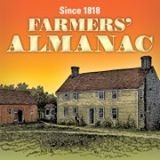 The newest edition of The Old Farmer’s Almanac predicts that the upcoming winter season, December 2013 to March 2014, will be colder and drier than normal. The Old Farmer’s Almanac, published every September, is the oldest, continuous periodical in North America, according to its website, Almanac.com. It was first published in 1792 by Robert B. Thomas in Dublin, New Hampshire. The Almanac’s original purpose, as reported on its website, was to “record and predict astronomical events, tides, weather, and other phenomena with respect to time.” Thomas used a series of natural cycles to create weather forecasting formula, which have proven to be 80 percent accurate. Over the years, calendars, recipes, and other additions have been included, but the Almanac is still best known for its long-range weather forecasts, which can include predictions for even a year ahead.
The newest edition of The Old Farmer’s Almanac predicts that the upcoming winter season, December 2013 to March 2014, will be colder and drier than normal. The Old Farmer’s Almanac, published every September, is the oldest, continuous periodical in North America, according to its website, Almanac.com. It was first published in 1792 by Robert B. Thomas in Dublin, New Hampshire. The Almanac’s original purpose, as reported on its website, was to “record and predict astronomical events, tides, weather, and other phenomena with respect to time.” Thomas used a series of natural cycles to create weather forecasting formula, which have proven to be 80 percent accurate. Over the years, calendars, recipes, and other additions have been included, but the Almanac is still best known for its long-range weather forecasts, which can include predictions for even a year ahead.
Predictions from the Almanac cover different major cities in each state. For the Paterson, New Jersey area, the winter looks long and cold: Early and mid-December and February will have the lowest temperatures and heaviest snowfalls. The average temperature for December will be 35 degrees.
The Old Farmer’s Almanac was originally just named The Farmer’s Almanac, according to the periodical’s website. “Old” was added to the title from 1832-1835, removed, and then added again in 1848 by the editor at that time, John H. Jenks. In its first year, the Almanac had 3000 copies in circulation; by its second year its circulation had tripled to 9000 copies. Numbers have increased every single year (except for 1938 when the editor Roger Scaife mixed up the weather forecasts for precipitation and temperature averages.
Interestingly, The Old Farmer’s Almanac was nearly accused of aiding a German spy in 1942. According to the story on Almanac.com, a German spy was captured shortly after arriving in Long Island, New York. In his possession was a copy of The Old Farmer’s Almanac. The government was suspicious that the weather forecasts published in the Almanac served as indirect information to the enemies. The Almanac’s editor, Robb Sagendorph, assured the government that the Almanac would publish weather “indications,” instead of “forecasts,” in compliance with the “Code of Wartime Practices for the American Press.”
According to the Almanac’s website, “Our operation is based in Dublin, New Hampshire. The words of the Almanac’s founder, Robert B. Thomas, guide us still: ‘Our main endeavor is to be useful, but with a pleasant degree of humor.’”
